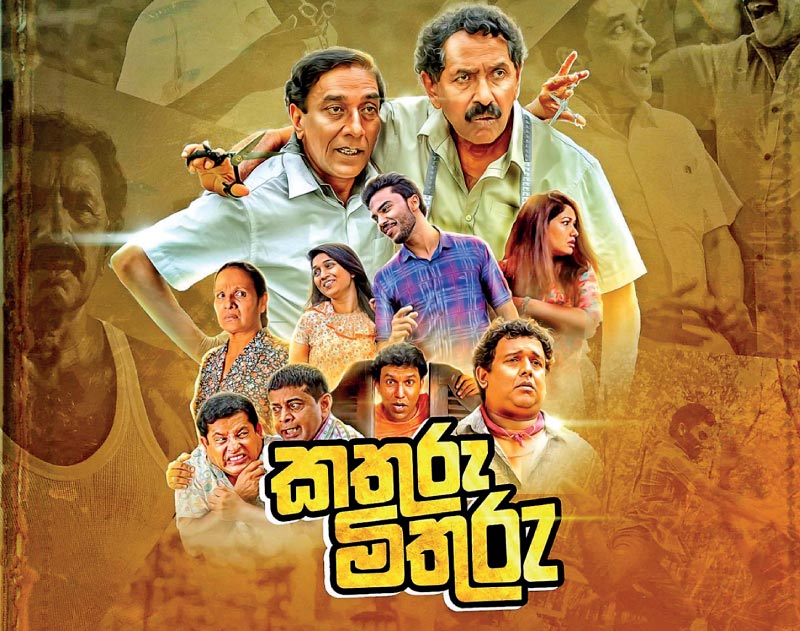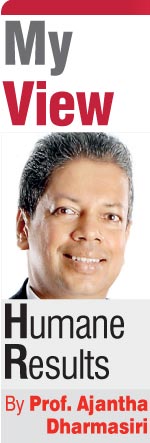Saturday Apr 19, 2025
Saturday Apr 19, 2025
Monday, 26 February 2024 00:15 - - {{hitsCtrl.values.hits}}

 I enjoyed watching a Sinhala movie after a while, in a sophisticated multi-plex away from Colombo. Despite the fret and fatigue, we experience on multiple fronts, an occasional shift from seriousness to serenity will always pay its dividends. Let me attempt to have a management reflection on the movie titled “Kathuru Mithuru” (literary meaning “Scissor Friends”) involving a barber and a next-door tailor.
I enjoyed watching a Sinhala movie after a while, in a sophisticated multi-plex away from Colombo. Despite the fret and fatigue, we experience on multiple fronts, an occasional shift from seriousness to serenity will always pay its dividends. Let me attempt to have a management reflection on the movie titled “Kathuru Mithuru” (literary meaning “Scissor Friends”) involving a barber and a next-door tailor.
Overview
A saloon and a tailor-shop next to one another are by no way an exception. Yet, having a solid friendship between the two “scissor handlers” for an extended period is something exceptional. Their respective son and daughter, being graduates yet deciding to follow their fathers’ footsteps in rather unusual. The cinematic plot impactfully portrays the leap from a traditional operation to a technology-infused modern trade, ably managed by the next generation.
The movie directed by veteran actor cum script-writer, Giriraj Kaushalya features popular artists such as late Jayalath Manorathne, Mahendra Perera, Rodney Warnakula, Priyantha Senavirathne and Gihan Fernando. Among the technical crew, Ruwan Costa as the cinematographer, Ajith Ramanayake as the editor, Priyantha Dissanayake as the make-up artiste and Nilantha Priyadarshana as the production coordinator appear promptly, whilst Basuru Siriwardana is the producer. The music was directed by Dr. Rohana Weerasinghe with the lyrics for the film written by Bandara Eheliyagoda, Nilar N. Cassim and Achala Solamans.
The movie, “Kathuru Mithuru” is Giriraj’s third direction having already delivered two comedies, namely “Sikuru Hathe” and “Suhada Koka.” He has earned a reputation for rich humour linked to typical human behaviour. It’s sad to hear the much delayed release of the movie due to the death of veteran artist Jayalath Manorathne, and the challenging terminal illness of Giriraj Kaushlya. In a way, it portrays “joyful suffering” which is the reality of many of our lives.
Story in a nutshell
Wilson, a traditional barber and Samson, a seasoned tailor are best friends that bond goes beyond blood ties. Wilson’s daughter and Samson’s son both leave the village to pursue higher studies in state universities. They come back and strive to find suitable employment without much success. As the two fathers are “mango friends,” the two children also develop a friendship that turns into an affair.
At the peak of frustration of not being able to secure a job, both the youngsters decide to follow in the footsteps of their respective fathers, despite much objection from both families. The parents appear to be frustrated to see their much educated children, instead of doing respected “government jobs” now trying to do ordinary and menial stuff. The reality is unfolded otherwise. Technology is infused into traditional tasks and modernity added to mundane affairs. The end is rather symbolic of how family entrepreneurship should foster in taking a conventional business to coveted heights.
Moving beyond the abundant humour, multi-faceted humanity is depicted in a memorable manner connecting both rural and urban settings. The way I think, the movie deserves to be viewed in cultural, generational, and entrepreneurial perspectives.
Cultural perspective
Culture is simply the “way we do things.” It is also described as “collective mental programming,” where certain patterns of behaviour may show certain identities. The Sri Lankan rural culture has been identified through research as a “collectivistic” enriched with religious traditions. Despite the impact on globalisation and digitalisation, a humane approach to business is still in existence. The movie portrays the warm human relationships and authentic customer care, especially in assisting the elderly for their needs without seeking money.
In fact, Kathuru Mithuru is a depiction of rural Sri Lankan community with good and bad in co-existence. The way Wilson and Samson ran away to escape from Police, when the “illicit liquor joint” where they were in “high spirits” was invaded, shows this mixed nature of values in action. The rural thug with his gang coming and demanding “Kappan” (ransom) from each shop and the way almost all fearfully obliging was an evil that need to be uprooted. Interestingly, it was the daughter of Wilson who had the guts to tell her father not to give and challenges her lover to fight the mighty fellow to teach him a lesson. The guy has no choice but to show his true potential in fighting with the entire gang in defeating them and the thug runs away as in a typical Bollywood fighting scene.
When the modern saloon and the new-look clothing outlet were to be ceremonially opened, it was the two fathers who were invited to light the traditional oil lamp first. This shows the preservation of values among the young, with a fitting blend of technology and tradition.
Generational perspective
The differences in thinking and acting among two generations is clearly depicted in the Kathuru Mithuru movie. We clearly see the way Wilson and Samson approach business as typical “baby boomers” who are conservative, accepting the status quo and complacent with a meagre income. Their children represent the “millennial” mindset with associated ambitions.
As the scholars say, the millennials or generation Y employees have differences in their perceptions, preferences and performance. They are much more tech-savvy compared to their generation X predecessors, having been exposed to rapid advancement in information and communication technology during past decades. They are also for more flexible work arrangements. The rigid eight hour work rule will make them bored and unproductive. They are also much more ecologically conscious in going green. These triple aspects of tech-savyness, work flexibility and green-consciousness act as key indicators with regard to their preferences towards work arrangements.
We see the millennial mindset clearly in the two young lovers in the movie who came to Colombo to get professionally qualified in grooming and tailoring within a short span of time. They gently challenged the business models of their fathers and created innovative approaches for higher value creation for customers.
Entrepreneurial perspective
Entrepreneurship is often associated with true uncertainty, particularly when it involves something really novel, whose market did not already exist. However, even if a related market already exists, nothing guarantees that room exists for a particular new entry. Risk taking is part and parcel of it. “When everything seems to be going against you, remember that the airplane takes off against the wind, not with it,” so said Henry Ford, founder of Ford Motor Company.
The spirit of Sri Lankan entrepreneurship has been a beacon of hope for the nation. Sri Lankan Entrepreneurship have taken the lead in fostering growth and economic development, creating, and sustaining businesses in challenging environments and have gone to yield outstanding results for the country. Small and Medium-Scale Enterprises (SMEs) in Sri Lanka account for 80% - 90% of the total number of enterprises, and the development of the sector is the key for resilient national economies, according to the Asian Development Bank. The backbone of this is entrepreneurship.
We see the movie Kathuru Mithuru portraying the endeavours of entrepreneurship of two youngsters who elevated their parental business fronts into much higher levels. We need to promote more entrepreneurs in the local soil. They need to have global reach with local roots. It is very encouraging to see the award schemes such as Entrepreneur of the Year felicitating the deserving candidates. Instead of finding comfort of the seashore of a stable organisation, some may enjoy launching a ship into a rough sea. That journey is entrepreneurship. With the required mindset of creativity and confidence, one can clearly see a dream and cleverly pursue the dream. That is how entrepreneurs succeed like the two younger generational characters in our movie.
Humour as a healer
I was recommended the movie Kathuru Mithuru by some relatives and friends. They shared the fun they had. I can vouch for the same. The power of laughter can provide humour and healing when life gets hard. As the experts say, the benefits of laughter are numerous, ranging from emotional well-being to physical health. Laughter causes physical changes in the mind and body reducing anxiety, stress, and depression. Humour helps us to counter stress hormones, increases endorphins, and helps us to connect with other people easier. As the much quoted adage states, “laughter is the best medicine.” Kathuru Mithuru movie gives us a heavy dose of it without any “double meaning” or “ethnic hating” aspects.
We can see Gelotology as the study of humour and laughter, and their effects on the body. Suzanne Steinbaum, cardiologist and director of Women’s Heart Health at the Heart and Vascular Institute, Lenox Hill Hospital in New York City, said in a 2014 Forbes magazine article about preventing heart disease: “It is also important to never forget to laugh. Laughter improves immune function, lowers blood pressure, enhances mood, and decreases stress and depression.” The movie Kathuru Mithuru amply provides it.
Way forward
“A well-developed sense of humour is the pole that adds balance to your steps as you walk the tightrope of life,” said William Arthur Ward. Having battered with a planetary pandemic and post-pandemic peris as a nation, we need a refreshing revival. Humour can play a role here. When we are much worried about TIN (Tax Identification Number), the courageous Belgian reporter TIN TIN (the popular cartoon character of Herge) must be much delighted that his name is widely referred in Sri Lanka.
The movie Kathuru Mithuru is an invitation to go beyond humour in search of humanity. It sprinkles freshness into us where pressing issues need to be tackled with creative solutions with a refreshed mind. The message is relevant to individuals, institutions, and the nation alike.
(The writer, a Senior Professor in Management, and an Independent Non-executive Director, can be reached at [email protected], [email protected] or www.ajanthadharmasiri.info.)
Discover Kapruka, the leading online shopping platform in Sri Lanka, where you can conveniently send Gifts and Flowers to your loved ones for any event including Valentine ’s Day. Explore a wide range of popular Shopping Categories on Kapruka, including Toys, Groceries, Electronics, Birthday Cakes, Fruits, Chocolates, Flower Bouquets, Clothing, Watches, Lingerie, Gift Sets and Jewellery. Also if you’re interested in selling with Kapruka, Partner Central by Kapruka is the best solution to start with. Moreover, through Kapruka Global Shop, you can also enjoy the convenience of purchasing products from renowned platforms like Amazon and eBay and have them delivered to Sri Lanka.
Discover Kapruka, the leading online shopping platform in Sri Lanka, where you can conveniently send Gifts and Flowers to your loved ones for any event including Valentine ’s Day. Explore a wide range of popular Shopping Categories on Kapruka, including Toys, Groceries, Electronics, Birthday Cakes, Fruits, Chocolates, Flower Bouquets, Clothing, Watches, Lingerie, Gift Sets and Jewellery. Also if you’re interested in selling with Kapruka, Partner Central by Kapruka is the best solution to start with. Moreover, through Kapruka Global Shop, you can also enjoy the convenience of purchasing products from renowned platforms like Amazon and eBay and have them delivered to Sri Lanka.